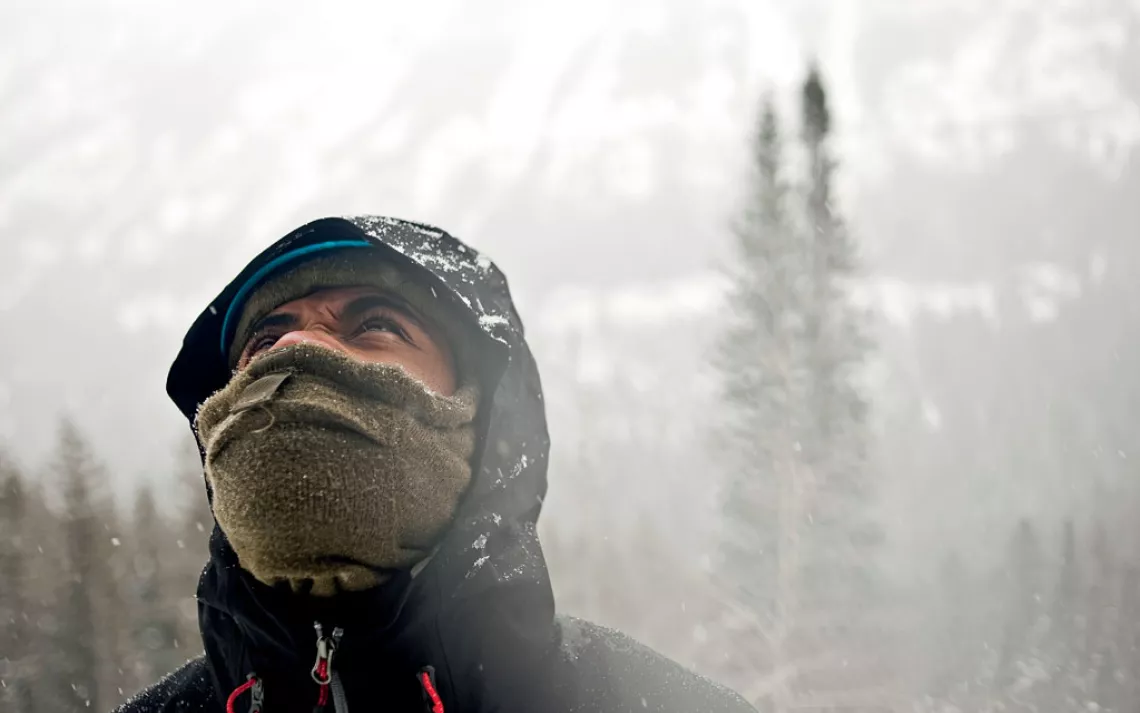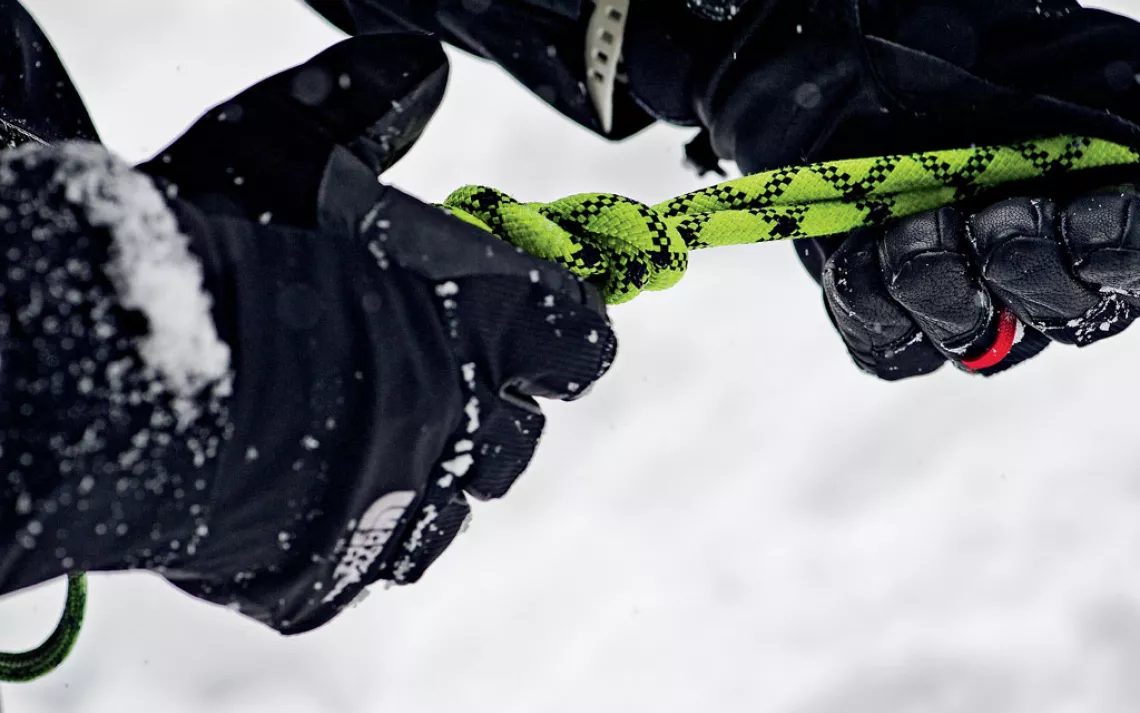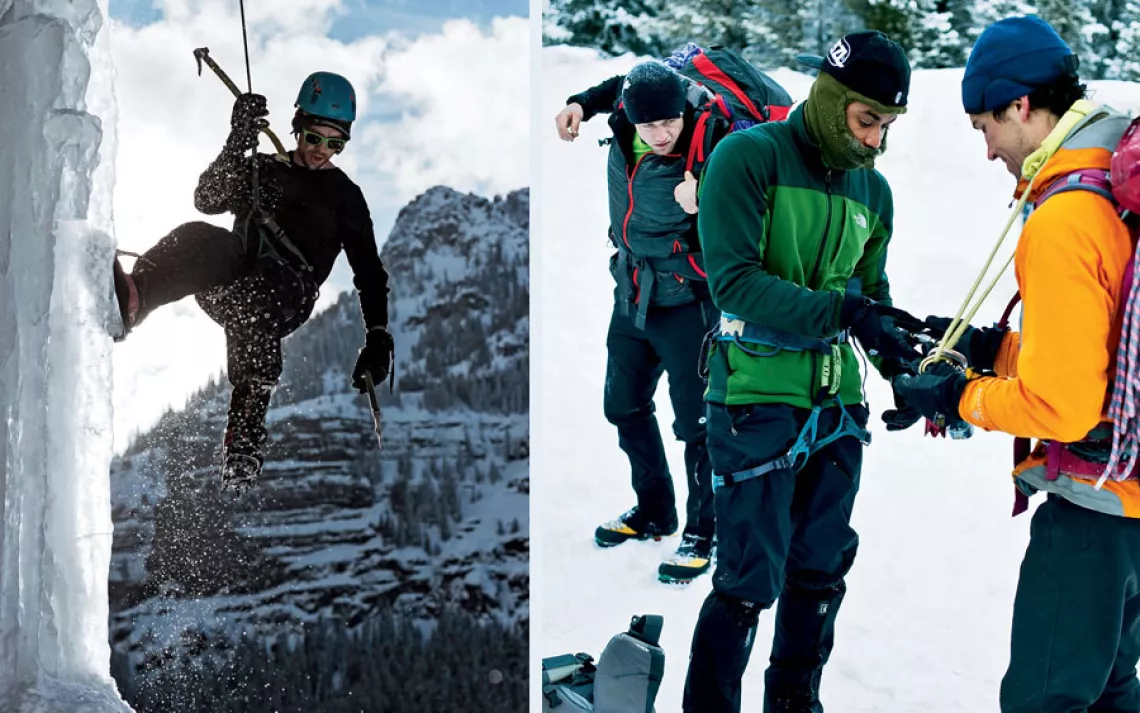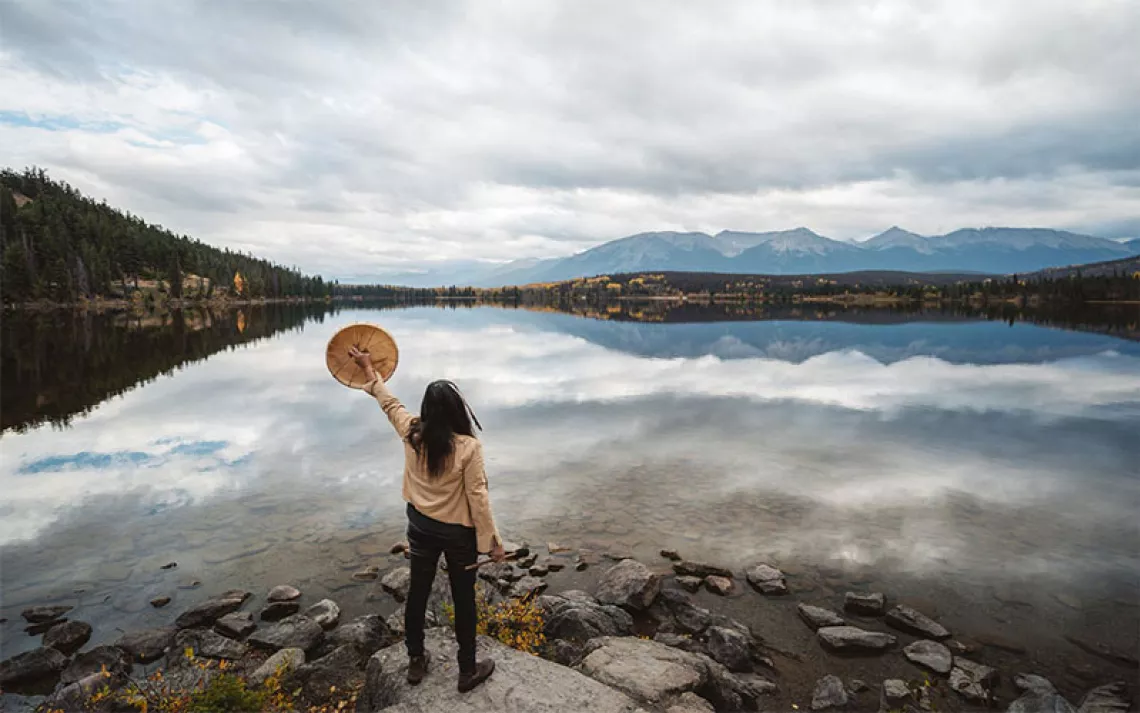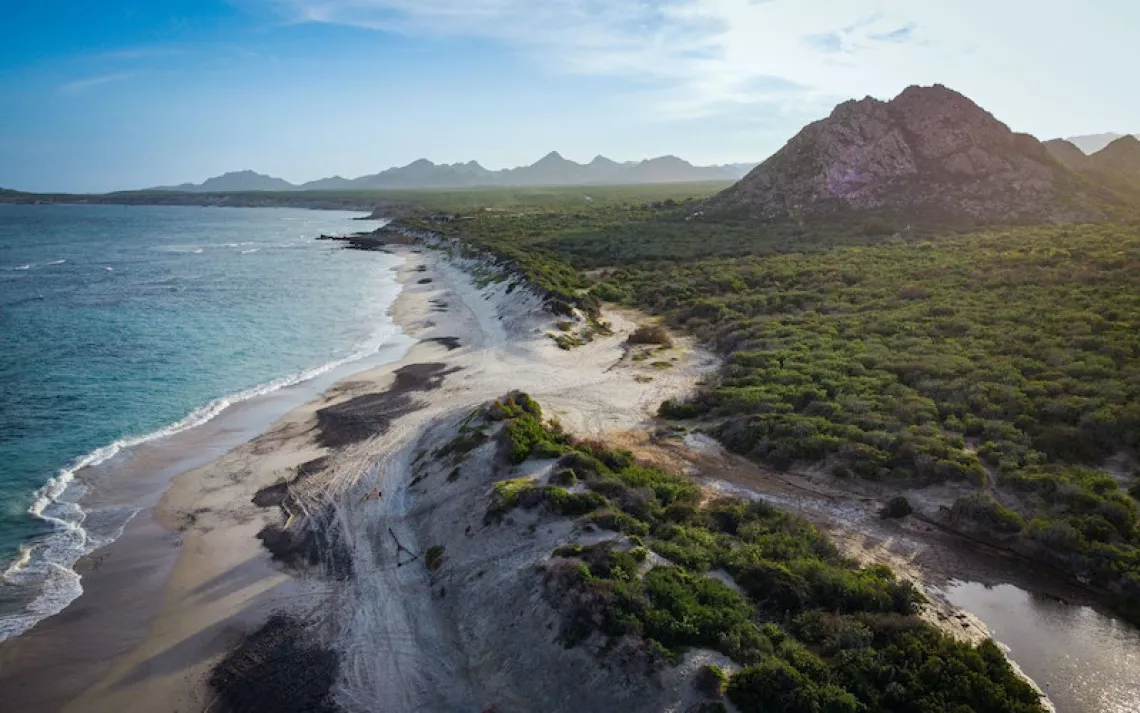On a frozen Morning in Montana, voices rise from a Forest Service cabin where 11 ice climbers warm their hands on bowls of oatmeal. It's early, the sky bright, the canyon still cold and shady. They're getting ready to clean up and head out, and they notice the absence of the 12th.
"Did Demond get food?" one of them asks.
"Dude should eat." "I think he's over by the fire."
Fifty yards through the cold, Demond Mullins sits in a snow crater watching embers from last night's fire flicker back to life. A band of light spreads down the peaks above him. Snow floats off a tree and comes to rest on his sticky-wet eyelashes. It melts outward into gobs of water, held together by each tiny hair. He stokes the fire with a piece of Douglas fir.
Mullins watches the fire for a long time. "There is never silence where I live. There is always someone in the apartment upstairs, footsteps," he says. Here in the canyon, his mind is as quiet as the snow, until he hears his name in the air—a flash of sound that dies immediately. He trudges toward the cabin.
The door opens with a creak. There is a change when he enters, subtle but sure. As he glides by the oatmeal buffet, climbers reorganize themselves around him, shuffling a couple of inches or tilting a few degrees. Often the most handsome and athletic person in a room, Mullins can shift the atmosphere with his mood. He overhears two climbers talking about the skateboards they rode as kids and suddenly bubbles over, laughing and asking questions. He tells a story about how he likes to get on his board and let his dog pull him around Brooklyn.
After a few minutes, the skateboarding conversation slows into silence, and Mullins's enthusiasm gives way to an aloof pensiveness. Spooning oatmeal, he merely smiles when people say, "Good morning," or "How are you?" Now 31, he has been an orphan, a dancer, a model, a soldier in the Iraq War, the subject of a documentary, and a Ph.D. student—in that order. In the next six months he will become a husband and a professor.
"Let's get ready to go," someone says.
Like everyone else here, Mullins is a veteran of the post-9/11 wars. When he returned to New York from Iraq in 2004, the city of his youth had warped into a collection of imagined threats—the civilians reaching into their coat pockets, the muffled sounds through the wall, the dark cars that seemed to follow him home from the subway. This trip, organized by the Sierra Club Outdoors program, is designed to give him tranquility and structure, respite from the urban clamor. It's also designed to teach him a new adrenaline sport, something that matches the exhilaration of combat but is viable for a life without weaponry or body armor.
Two days ago, Mullins flew to Bozeman, where he met the rest of the group at a gear shakedown in the basement of a hotel. The room was full of boxes and rubber tubs containing donated equipment for the novice climbers. The contents soon overflowed into tangles of harnesses, clumps of long underwear, and piles of gloves, sleeping bags, and shiny, ultrawarm coats. The four guides walked around to see that the participants, who were already bonding over their collective lack of winter-camping savvy, packed the right combination of stuff.
"I have two lightweight tops, a midweight top, plus these," said Mark, a former Army Ranger from New York City with a voice like a coffee grinder, who had laid three jackets of varying puffiness at his feet. "I'm swimming in these pants," said Josh, a former Army major from Tacoma, Washington, who, at five feet eight, was trying on an extra-large snow bib.
One climber went up to another and said with genuine concern, "You're wearing a women's helmet. Take this one instead."
Near the room's center, Mullins pulled some clothes from the boxes and slipped them on without hesitating, looking every bit the former model. But then he was thwarted by an ill-fitting glove.
"You want three pair of gloves. One for climbing, one for when those get wet, and one for when those get wet," a guide called out.
Mullins raised his gloved hand and repeatedly squeezed it into a fist. "How much space should I have in my fingers?" "Here," Mark said, raising his palm. They matched hands and decided that Mullins's long fingers should have the large gloves.
Amid all this, the group made small talk. It was mostly an inquisitive discussion of everyone's origins and current homes, with an undercurrent of aspiration. They discussed the topography of Indiana, the abundance of bluegrass concerts in Denver, the noise of New York, and the lurking smog over Salt Lake City. They seemed on the constant cusp of something. Many hoped to go to school, or they were in school and trying to pay for the next semester, or they were talking about starting businesses. In every case, they looked for clues in one another, eager to learn from other veterans' postwar successes.
Mullins stands at the base of a waterfall, roped in and ready to—as one guide put it—"beat the crap out of some ice."
The belayer checks Mullins first. "Five pairs of rope. Knot looks good. Harness looks good. Is that it?" "Nice," Sam Magro, a local guide, says. "Now check him, Demond." "Carabiner locked. Harness is good. OK. I think we're ready?" They both look at Magro. "All right. You guys are set. Let's do some climbing!"
With his crampons and ice tools (which have curved handles for climbing—unlike ice axes, which have straight handles for walking overland on ice), Mullins fastens himself to the frozen waterfall.
At first, it's easy for him. The ice is beautiful—deep blue and denuded from the season's climbers. His technique is bad—instead of hooking his spikes in crevices and pockets that already exist, he swings like a miner, creating his own holes—but he's athletic enough to compensate, muscling upward steadily. Kick, kick, swing, swing. Kick, kick, swing, swing.
When Mullins is 30 feet up the wall, Magro yells, "You don't need to kick so hard! You just need to rest your toes and your axes in the pockets!" "Ice!" is Mullins's response. Huge shards rain down onto people's shoulders. He continues up the column—kick, kick, swing, swing. Kick, kick, swing, swing—but soon he tires, and he responds by kicking harder. He kicks so hard that the ice he wants to stand on simply cracks off the wall. He tries to rest, crouching on his toes and curling up like a quarter note, right arm strained vertically above his balled body. "Stand up!" Magro yells. "What?" "Stand! Up! Use your legs to support your body!"
"I can't!" Earlier, Magro had described a certain triangle form, legs wide and extended with one anchored tool overhead, the other free to search for a hold. That's how Mullins is supposed to look now, but his awkward pose won't allow it, and his arms begin to burn. At home, he likes to play around in a rock gym, which gives him strength in the knuckles and fingertips. But he hasn't worked up the right muscles to hold his body weight from an ice tool. "Drop your heels and stand up!" "My forearms are really tired!" "Can you stand on your legs?"
"OK. I'm gonna try!" With that, he unsticks the tool and swings hard. But it jiggles out of control. Like machines running out of electricity, his hands power down and then off. "Dropped my ax!" he yells. Both tools soar to the ground.
A participant descends after topping out on his final climb of the trip.
He is lowered and immediately says, "That was hard. Anyone need a belay?" As he unknots his rope, his smile turns into a pained expression, and he begins to gently move his fingers. He has succumbed to that torturous rewarming of the extremities that climbers call "the screaming barfies."
For the rest of the day, the 12 vets rotate on and off the ice, swapping partners, trying climbs of different grades, getting the screaming barfies. Nick—who lost much of his left hand in a stove explosion after leaving the military—tests a leash he devised to leverage his grip. A few Air Force guys cook coffee on a stove, and one of the guides shows some hungry climbers how to make a snack from a tortilla, peanut butter, and granola bar crumbs. Mullins works on his climbing technique and a few hours later can be heard saying, "Man, I got to figure out how I can do this two or three times a year!"
"It's good to have some time to reflect," Mullins says. "Not just on the war, but on my life as a whole. I've lived such a weird life. I often feel like I've lived several lives in one."
Mullins has always been in transition, jerking between realms most people consider distinct. At 11, he was recruited from his elementary school in the Bedford-Stuyvesant neighborhood in Brooklyn to attend a ballet magnet school in Manhattan. Every day he rode the A train from Bed-Stuy to Chelsea and back. His stepfather hated him because he was another man's child, and by 16 he had run away from home but was still going to the ballet academy and paying rent in a friend's apartment by selling pot at night.
After high school, Mullins was admitted to New York University's prestigious Tisch School of the Arts program for modern dance, but he couldn't afford the tuition, so he started modeling. He was sent to trade shows in Las Vegas, where he skateboarded around a convention center while buyers appraised whatever clothes he was wearing. In 2000 he joined the National Guard, hoping he could finally go to school once he finished his service. Then September 11, 2001, came along. Mullins was training at Fort Knox, Kentucky, when they marched his company into a large room where a TV showed images of the towers collapsing over and over. The sound was off, the room full of whispers that said, "We are going to war."
Several months later, he was spending his days guarding Penn Station with an automatic rifle, teaching dance classes on the side. During one class, he got a call from his commander. As second-graders pirouetted past him, he learned that his troop was being deployed in a month.
He rode into Iraq from Kuwait in a floorless Humvee. As part of the search for weapons of mass destruction, he invaded hundreds of Baghdad homes. He assaulted the inhabitants, pointed guns at them, detained them. Everything happened in the middle of the night. It felt like kidnapping. Once, he was reprimanded for not shooting a man holding a dark, half-concealed object, which turned out to be a broom. Amid the violence, there were also moments of joy. He taught a bunch of soldiers to dance. He remembers the pleasant flakiness of a homemade baklava that a woman offered him while he stood guard outside a house. On a sunny day on the outskirts of Baghdad, he ate the best piece of fruit of his life—a paper-skinned pocket of sugary mush that a commander told him to bite into while they hid amid trees from sniper fire. He still isn't sure whether it was a fig or a date.
"I did horrible things to people," he says. "I assaulted their human dignity."
The vets standing with him now, along the bottom of this ice cliff, understand that the war was the world at an angle, heat-blurred and shifted, a thing that sent you ricocheting between extreme fear and extreme joy and forced you to choose on a daily basis between yourself and another human. Then you come home, and your daily decisions are what to buy and wear and eat.
Mullins looks up to the very top of the frozen waterfall, a peaceful, airy spot above the trees. He gingerly hooks one ice tool into a preexisting hole, then the other, and hoists himself upward.
 The Magazine of The Sierra Club
The Magazine of The Sierra Club
